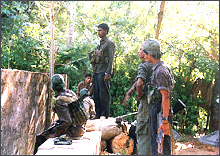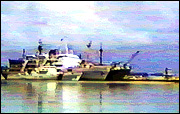
Feeding Mars in Jaffna
[TamilNet, Tuesday, 06 June 2000, 23:59 GMT]
Jaffna has been supplied by air and sea for almost a decade. However, this is the first time the sea and air supply facilities of the SLA in the northern peninsula have been threatened directly. Sri Lanka's Deputy Defence Minister acknowledged last week that the Liberation Tigers are firing a large number of shells on the Sri Lankan army's Palali base complex, which includes the Kankesanthurai harbour.
This has given rise to a logistical quandary that the SLA was little prepared for until the fall of the Elephant Pass garrison in April this year. The problem has to be viewed in the context of the fact that the territorial gains the Tigers have made inside the peninsula have given them a singular logistical advantage that they never enjoyed before (from the inception of the Tamil insurgency that is) and provided them a launching pad for directly threatening the SLA's supply facilities in Jaffna.
This is the first time in the history of Tamil militancy in Sri Lanka that all the access routes to the peninsula from the Vanni mainland (Elephant Pass, Chundikulam and Pooneryn) have completely gone out of the SLA's control.
The central military question in Jaffna, therefore, revolves round the SLA's logistical quandary and its offensive capability to neutralise the threat posed by the LTTE to the army's supply facilities in the peninsula. Gen. Ratwatte asserts that morale is now high among the SLA soldiers fighting the Liberation Tigers in Jaffna following the infusion of modern weaponry and the encouragement provided by him during tour of the battle zones of the peninsula.
However, it is still not clear how long it might take to translate this high morale among SLA troops into decisive offensive action when one surveys the press releases put out by the Special Media Information Centre (SMIC) set up under the draconian emergency regulations to issue reports that are the only source of publishable information on the war available to accredited journalists in Sri Lanka.
The SMIC said on May 30 that the SLA had advanced on May 29 from two locations towards LTTE held positions in Ariyalai, Sarasalai and Chavakachcheri.

The Special Media Information Centre said in its situation report of June 1, "On 31st May around 3.30 p.m terrorists attacked the Security Forces defences at Colombuthurai with small arms and mortars".
Columbuthurai is a coastal suburb of Jaffna town about two kilometers west of Ariyalai. That the Tigers were attacking SLA positions in this suburb barely a day after the offensive on Ariyalai, Chavakachcheri and Sarasalai shows clearly that the May 29 operation had no effect by way of retaking lost territory or of blunting the LTTE's retaliatory or counter attack capability.
Another SMIC report published the same day on the Sri Lankan government's official website acknowledges in typical euphemism that the SLA inflicted heavy casualties on the Tigers in "operations conducted on May 29 in the Colombothurai self-styled (sic) and Chavakachcheri areas" but "had to abandoned (sic) the search as the terrorists were firing mortars at the troops".
The following facts, therefore, will stand out very sharply in any description of the current military situation in the Jaffna peninsula even if it were to be based solely on the pronouncements of the Gen.Ratwatte and the SMIC.
1.The SLA's only viable supply points in the Jaffna peninsula proper (excluding the Sri Lanka naval facilities in the island of Karainagar) are under artillery and mortar attack by the Tigers.
2. The SLA still lacks the offensive capability and initiative (which it lost in late December 1999. see TN features) to retake areas that provide the Tigers the vantage points to threaten the two vital supply points with mortars, artillery and, in the future, with massed troops and special forces. It might be worth pointing out here again that it was precisely this lack of offensive capability on the part of the SLA (and to some extent the pre-emption of it by the Tigers on March 26) that chiefly contributed to the fall of Elephant Pass, Iyakkachchi and Pallai and later to the fall of Thanangkilappu, Ariyalai, Navatkuly, Kaithady and Chavakachcheri.
The neutralising of the SLA's offensive capability in the peninsula by late December 1999 was the main reason that helped the LTTE fortify and develop the two vital beach heads in Vettrilaikerni, east of Elephant Pass and the Thanangkilappu - Kerathivu sector, southeast of Jaffna town as launching pads for the two strategically decisive territorial acquisitions it made in the peninsula.
The direct and real threat to the SLA's only supply points and the determination of the Sri Lankan government to 'correct' the army's apparent lack of decisive offensive capability in the peninsula today with more arms point to a logistical quandary.
The SMIC says new weaponry, including multi barrel rocket launchers, is being infused into the SLA's arsenal in Jaffna. Iqbal Athas, Sri Lanka's leading defence correspondent says that the SLA now deploys the deadly 30-barrel rocket launcher supplied by Pakistan.
The scale of current arms purchases by the government makes it clear that the SLA in Jaffna will receive, among other things, more area weapons which no doubt will be the main component of the new military acquisitions for Jaffna. A brief history of the demands made by the SLA for more powerful area weapons shows that it has, over the years, become increasingly dependent on high volumes of fire support.

The infusion of new area weapons such as multi barrel rocket launchers will certainly raise the volume of this fire support further. The LTTE currently holds two significantly large areas inside the peninsula which the army has to necessarily 'soften' with high volumes of artillery and rocket fire in the hope of deterring the Tigers from achieving a decisive concentration of forces to renew their advance into Jaffna. (This is in marked contrast to the situation until late December 1999 when the area immediately south of Elephant Pass and Paranthan was the main 'target territory' that had to be pounded with heavy volumes of sustained artillery fire to 'soften' LTTE positions and possible build up of its forces.)
In short, the ammunition depletion rate in Jaffna is unprecedented and bound to rise inexorably with each minor probing action or maneuvering thrust by the LTTE. Or in other words, the supply of ammunition and related war material has to be stepped up in proportion to the degree of direct threat posed by the Tigers to Jaffna's only supply facilities.
Unwittingly but inevitably, the Sri Lankan government has created the conditions for an unprecedented demand for artillery shells, mortars and rockets precisely at the juncture where the SLA's life lines to Jaffna, according to Sri Lanka's Deputy Defence Minister, are being heavily shelled by the Tigers.
But then it is argued that the SLA's supply problems in the peninsula are not unmanageable because food and related provisions for the army can be obtained in the peninsula itself. But this is possible only if sufficient arable land is held by the SLA under conditions in which farmers can cultivate and produce sufficient surplus for the consumption of the troops. But this argument assumes the Tigers would not be able to make any more territorial gains in the peninsula or that the SLA will soon be able to recapture at least part of what it lost to the LTTE after the fall of Elephant Pass.
However, even if food can be obtained locally it won't be the solution to the SLA's logistical quandary in Jaffna today because of the fundamental fact that subsistence accounts only for eight to twelve percent of all supplies a modern army needs. (Supplying War: Logistics from Wallenstein to Patton - Martin Van Creveld p.233)
Therefore, the question would still be about the ability of the SLA to feed the tremendous depletion rate of all non-subsistence supplies, including ammunition, in the context of vulnerable supply lines. If the army cannot dislodge the LTTE from the areas it captured in the peninsula since April 22, then the only solution to this problem would be to amass military supplies in the Palaly base complex before the Tigers begin the next phase of Operation Unceasing Waves III.
Again this is catch 22 for the SLA.
The stockpiled war material could become a burden firstly when internal lines of supply are destabilised and secondly when the SLA's supply facilities in the peninsula stand exposed to more direct assaults. But even if the dangers inherent to massing up supplies in a place like Jaffna are clearly foreseen, the SLA cannot completely and prudently avoid them now.
Stockpiling supplies in a place that can be reached only by air and sea is generally considered unwise when the defender's airlift capability and supply ships are limited; and more so when the place has one minor harbour and one airstrip, both of which are being hit by enemy fire.
The more an army masses up military supplies in such a place, the greater the burden on its contingency planning because at the end of the day if one has not been successful in stopping the enemy's advance closer to one's strategic positions then it would be virtually impossible to include the stockpiled material in any withdrawal plan, as these would far exceed the logistical capability one may muster in a crisis, including foreign assistance.
This is why the SLA was quite correct in categorically rejecting the contingency plan for withdrawing troops from Jaffna. From a strictly logistical point of view, any withdrawal plan short of full-scale foreign intervention for the purpose has to preclude the military supplies being stockpiled in Jaffna. (There are other valid reasons as well for the SLA dismissing suggestions about evacuating its troops from the peninsula)
Therefore the Sri Lankan government's decision to defend Jaffna to the last man is quite correct logistically just as much as it is justifiable politically and strategically.
But this, however, might precisely be what the LTTE expects the SLA to do in Jaffna.







 The Special Media Information Centre said in its situation report of June 1, "On 31st May around 3.30 p.m terrorists attacked the Security Forces defences at Colombuthurai with small arms and mortars".
The Special Media Information Centre said in its situation report of June 1, "On 31st May around 3.30 p.m terrorists attacked the Security Forces defences at Colombuthurai with small arms and mortars".  The infusion of new area weapons such as multi barrel rocket launchers will certainly raise the volume of this fire support further. The LTTE currently holds two significantly large areas inside the peninsula which the army has to necessarily 'soften' with high volumes of artillery and rocket fire in the hope of deterring the Tigers from achieving a decisive concentration of forces to renew their advance into Jaffna. (This is in marked contrast to the situation until late December 1999 when the area immediately south of Elephant Pass and Paranthan was the main 'target territory' that had to be pounded with heavy volumes of sustained artillery fire to 'soften' LTTE positions and possible build up of its forces.)
The infusion of new area weapons such as multi barrel rocket launchers will certainly raise the volume of this fire support further. The LTTE currently holds two significantly large areas inside the peninsula which the army has to necessarily 'soften' with high volumes of artillery and rocket fire in the hope of deterring the Tigers from achieving a decisive concentration of forces to renew their advance into Jaffna. (This is in marked contrast to the situation until late December 1999 when the area immediately south of Elephant Pass and Paranthan was the main 'target territory' that had to be pounded with heavy volumes of sustained artillery fire to 'soften' LTTE positions and possible build up of its forces.)